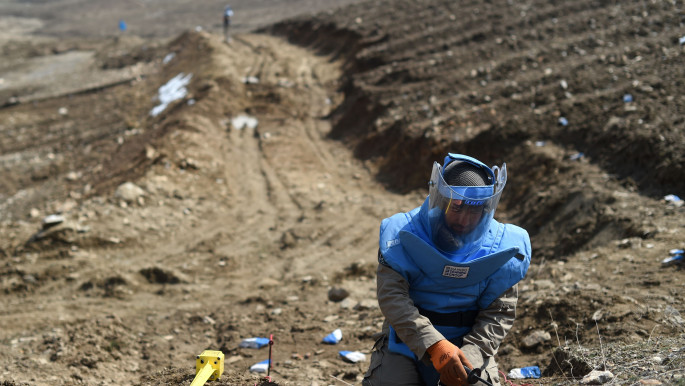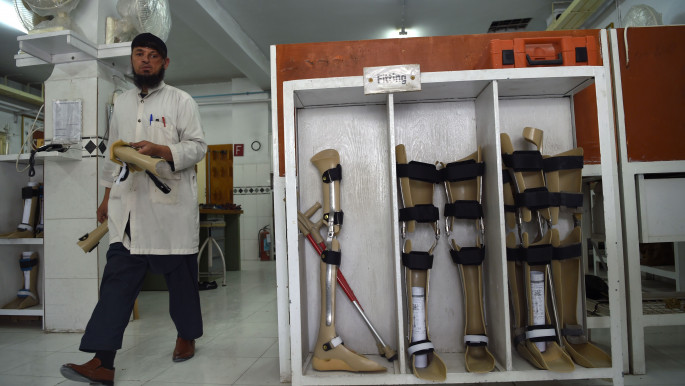Remnants of War: Afghanistan's landmine crisis continues
Back in 2012, Mirzai was in Herat with his father when a remote-controlled landmine exploded in his car. The Taliban targeted him because of his work with the American Red Cross. After two months in the hospital, Mirzai learned his father, a passenger in the car, had been killed and that Mirzai would have to have his leg amputated. The Taliban continued to send him death threats.
Now, Mirzai attends Sciences Po, one of the most selective universities in Paris. His goal is to return to Afghanistan and improve the quality of life for the handicapped population.
"Handicapped people – they can't work for the government and other people [in Afghanistan]. That breaks my heart," said Mirzai, now 25. "They can't study, they can't [work], what can they do? And there [are] no people to help them."
Mirzai's story is not unique. And as the 17-year war drags on and foreign aid funding decreases, refugees like Mirzai and civilians who've remained in Afghanistan bear the scars. With less international focus on the region as an active war zone, the financial support continues to decrease, putting survivors at risk.
 |
The use of IEDs by non-state actors, like the Taliban and the Islamic State group, accounted for approximately 60% of all casualties recorded from January 2016 to February 2017 |  |
"Afghanistan was a lead programme, it was the most, probably still, one of the most heavily contaminated countries in the world and obviously impacting it's pre-, during, and post-conflict recovery efforts," said Rodney Robideau, a programme manager in the State Department's Office of Weapons Removal and Abatement.
 |
|
| Shikhali Mirzai, 25, an Afghani refugee speaks to a group of high school students at the The American School of Paris [Dorothy Mills-Gregg] |
The use of IEDs by non-state actors, like the Taliban and the Islamic State group [IS], accounted for approximately 60 percent of all casualties recorded from January 2016 to February 2017, according to Afghanistan's Directorate for Mine Action Coordination. There have been 32,307 civilian casualties have been recorded since the programme started in the early 1990's.
Three million affected
But those who survive attacks, like Mirzai, are left with too many burdens and not enough resources. There are about three million people in Afghanistan living with physical disabilities, and that number increases by about one- to two-thousand amputees every year, according to Eric Weerts, a rehabilitation specialist at Humanity & Inclusion.
For most of the people they help, Weerts said the pathway to care includes a pre-fitting for prosthetics, wound healing and referral to a fitting centre, though finding one that's accessible is another challenge.
Not only do they have to consider location, but it becomes a financial burden with routine check-ups for fittings every four to five years, which are even more frequent for children.
 |
There are about three million people in Afghanistan living with physical disabilities, and that number increases by about one- to two-thousand amputees every year |  |
While those are the most straightforward routes, according to Weerts, "lots of amputations are being done as a last resort because sometimes specific injuries do not get the care that is needed in the aftermath."
And this is problematic because hospitals are unprepared for an influx of patients with life-threatening injuries, Weerts said.
 |
|
| According to the United Nations Mine Action Service, casualties from landmines and so-called 'explosive remnants of war' have soared five-fold between 2012 and 2017 [Getty] |
Unfinished business
In 2002, Afghanistan signed the Anti-Personnel Mine Ban Treaty, which has the stated goal of achieving mine-free status by 2023, but the reduction of international forces, including the US troop drawdown, has challenged the timeline.
As of December 2017, more than 91-square-miles of contaminated land has been cleared. More than 330-square-miles of suspected and confirmed minefields, battlefields and high explosive areas remain.
"Unfortunately, the drawdown of forces and retraction of international donors and the economic downturn worldwide all came together for the perfect storm of donors pulling back," Robideau said.
The State Department has invested over $390 million for humanitarian demining and the US government as a whole has invested over $450 million since 1993, he said.
The fiscal year 2018 budget for Afghanistan mine action programmes is $20 million, which has decreased by almost half since its peak of $45.8 million in fiscal year 2010. Robideau said the president has asked to hold that $20 million steady in fiscal year 2020.
"I will honestly say that getting funds released through the Congressional process can be extremely demoralising and bureaucratic!" Robideau wrote in an email.
And to gain more international interest and funding, Robideau hosted a forum to direct "any loose, un-forecasted funding" to his portfolio of countries which includes Afghanistan. "This is how I got an $11.7 million bump in 2017," he said.
 |
More than 330-square-miles of suspected and confirmed minefields, battlefields and high explosive areas remain |  |
As the largest nation donor, US support is crucial to demining efforts. Senator Bob Casey, D-Penn, a long-standing advocate for Afghanistan, said he will support continued funding.
The majority of Afghanistan's landmine and IED contamination goes back to the war between the Soviet Union and the Afghan Mujahideen.
"I think the fact that the work is focused in on helping communities and civilians and the fact that it's considered as a dignified form of employment and a respected form of employment – has meant that we've been able to work in different parts of the country at different times, under different regimes," said Calvin Ruysen, head of Afghanistan and the Middle East region at HALO Trust, a non-profit organisation that has been involved in the country since 1988 and has employed Afghanis with the gear and training necessary for removing explosives safely.
Read also: Photoblog: New sporting opportunities help Syrians find hope after losing limbs
Since demining operations began there has been a "fatwa," or agreement, from Taliban leadership to allow deminers to their work without being harassed or impeded, Robideau said.
This has been the case for the most part until 2015-2016 when the Taliban was under "extreme duress, stress," Robideau said. But many of these instances were criminally-linked, with groups robbing equipment or extorting ransoms for workers.
The increase was also linked to the US-funded firing range project, which brought commercial demining organisations that then faced the brunt of the kidnapping threats, said Patrick Fruchet, regional director at United Nations Mine Action Service. Of the 97 deminers kidnapped in 2017, 93 worked for commercial groups.
Fruchet said this is because non-governmental organisations work with community liaisons and commercial companies engage with local gunmen for protection.
Phase 2 of the firing range project is in the works, which Fruchet said "will hopefully be done in circumstance" to avoid those incidents. But to ensure demining work continues, the UNMAS consistently engages with Taliban leadership to revisit and reaffirm the agreement.
 |
|
| An Afghan orthopaedic technician walks past artificial limbs in a workshop at the International Committee of the Red Cross hospital for war victims and the disabled in Kabul [Getty] |
Remnants of war
As for the areas under government control and where fighting has ceased, HALO Trust and other NGOs work to restabilise communities since explosive hazards block access to water, farmlands, firewood, foraging, livestock and prevent infrastructure such as mosques and schools. But as civilian populations return home, this is when they are the most vulnerable, Ruysen said.
"What we're not going to wait for is the so-called 'guns to go silent' before we go [to] work," Fruchet said.
 |
What we're not going to wait for is the so-called 'guns to go silent' before we go [to] work |  |
As of July 31, 2018, the Afghan government controlled about 65 percent of the population, which is 21.7 million of an estimated 33.3 million total, according to a report from the US Special Inspector General for Afghanistan Reconstruction.
While US-Taliban peace negotiations continue, the Afghan government is left out of the talks. Although the mine-free target is still 2023, Robideau believes it will take longer.
As for the amputees, Weerts said the focus is more on the current state of affairs than a post-conflict society.
Read also: Gaza's amputees empowered with small business grants
"We don't see at the horizon yet, the reflection on what are the long-term services that these people need to attain certain quality of life," Weerts said.
"Because we look for the moment more at – saving lives, saving limbs, immediate support, immediate response but the long-term issues are not being considered."
For Mirzai, his future is invested in his own people.
"Why I'm trying to do something? Because I want to show that we can do something. Why am I telling my story for the people?" Mirzai asked. "To teach them life is not easy, and we can do everything if we want."
Patty Nieberg is a graduate student at Medill's School of Journalism and has previously covered national security and defence issues in Washington DC.
Follow her on Twitter: @pattynieberg





 Follow the Middle East's top stories in English at The New Arab on Google News
Follow the Middle East's top stories in English at The New Arab on Google News


